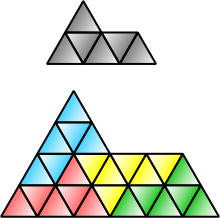Sphinx tiling

In geometry, the sphinx tiling is a tessellation of the plane using the "sphinx", a pentagonal hexiamond formed by gluing six equilateral triangles together. The resultant shape is named for its reminiscence to the Great Sphinx at Giza. A sphinx can be dissected into any square number of copies of itself,[1] some of them mirror images, and repeating this process leads to a non-periodic tiling of the plane. The sphinx is therefore a rep-tile (a self-replicating tessellation).[2] It is one of few known pentagonal rep-tiles and is the only known pentagonal rep-tile whose sub-copies are equal in size.[3]
General tilings
An outer boundary ("frame") in the shape of a sphinx can also be tiled in a non-recursive way for all orders. We define the order of a sphinx frame on a triangular lattice by the number of triangles at the "tail" end. An order-2 frame can be tiled by four sphinxes in exactly one way (as shown in the figure), an order-3 frame can be tiled by 9 sphinxes in 4 ways, etc. The number of tilings grows exponentially as with the order of the frame, where [4]
See also
References
- ^ Niţică, Viorel (2003), "Rep-tiles revisited", MASS selecta, Providence, RI: American Mathematical Society, pp. 205–217, MR 2027179.
- ^ Godrèche, C. (1989), "The sphinx: a limit-periodic tiling of the plane", Journal of Physics A: Mathematical and General, 22 (24): L1163 – L1166, doi:10.1088/0305-4470/22/24/006, MR 1030678
- ^ Martin, Andy (2003), "The sphinx task centre problem", in Pritchard, Chris (ed.), The Changing Shape of Geometry, MAA Spectrum, Cambridge University Press, pp. 371–378, ISBN 9780521531627
- ^ Huber, Greg; Knecht, Craig; Trump, Walter; Ziff, Robert M. (2024). "Entropy and chirality in sphinx tilings". Physical Review Research. 6 (1). arXiv:2304.14388. doi:10.1103/PhysRevResearch.6.013227. ISSN 2643-1564.
External links
- Mathematics Centre Sphinx Album ... [1]
- Weisstein, Eric W. "Sphinx". MathWorld.







